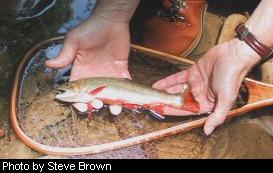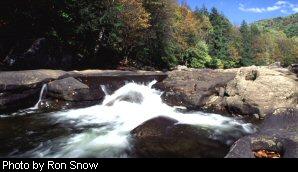

Summertime and the Fishing Is EasyBy Mike Shingleton
Many of the streams and small lakes stocked with trout during the spring will not support trout through the summer because of high water temperatures. However, numerous streams do support trout throughout the year. Most of these streams are located in the east-central mountain region of West Virginia. By the time trout stockings cease at the end of May, fishing pressure drops off significantly, when compared to the frenzy observed during March and April. Depending on the amounts of precipitation received during the spring, and subsequent rainfall throughout the summer months, many streams can provide excellent fishing opportunities for anglers throughout the summer. Many anglers are already familiar with streams where they can enjoy good trout fishing during the summer. This article is for anglers who have considered summer trout fishing—but haven't tried it yet, and those who might not know that trout fishing does exist after the trout stocking season is over. Some of the better known streams that provide anglers with good fishing this summer include the Cranberry, Williams and Elk rivers. Also, Shavers Fork, Blackwater , North Fork of the South Branch and Buckhannon rivers are worthwhile destinations. Anglers should not overlook smaller streams such as Glady Fork, Gandy Creek, Anthony Creek and its North Fork, or the West and East forks of the Greenbrier and a number of other similar streams. In addition to regularly stocked streams, anglers may want to try their luck on many of the catch-and-release areas maintained by the Division of Natural Resources. These areas, such as Elk River, Slaty Fork of Elk, Cranberry and South Branch of the Potomac rivers, and Glade and Paint creeks of the New River, along with others are described in the current edition of the fishing regulations. Remember these are catch and release, and in some cases, fly fishing only—all fish must be released. Many streams known to support trout year-round are stocked annually with fingerling brown trout. Some streams, such as Elk River and Shavers Fork have been previously mentioned. Others include Piney and Dunloup creeks near Beckley, Spruce Laurel Fork near Logan, South and North forks of Cherry River near Richwood and Little Sandy in Preston County. West Virginia also has many fine native brook trout streams, again primarily located in the east-central mountain region of the state. Many tributaries of the North Fork of the South Branch, Shavers Fork, Greenbrier River, Williams River and Elk River offer good brook trout fishing. These streams are generally small and will prove to be a challenge to most anglers. Fishing techniques employed for summer trout are usually different than those used in the spring. By summer, stocked trout have become accustomed to natural foods found in the stream. Mayflies, stoneflies and caddisflies abound in most of our coldwater streams. This is why fly fishing is one of the more popular methods of catching trout during the summer months. Anglers using spinning gear with small spinner flies will also enjoy good success.
Some streams maintain cold flows throughout the summer, particularly those that are shaded by trees. However, anglers will often encounter streams that seem to be too warm for trout. While trout may be spread out evenly in a stream during the spring, as the summer progresses, water temperatures will rise. In these situations, trout will seek out areas in a stream that provide a coldwater refuge. This often becomes the adventure part of summer trout fishing. Anglers, through experience and trial and error, must determine where the trout move to as water temperatures rise. Areas where anglers should concentrate their fishing efforts are around the mouths of tributaries, where springs enter a stream, or where, as they wade, they encounter colder water from groundwater upwellings . While, trout fishing during the summer and early fall can provide some very exciting and rewarding angling experiences, anglers should exercise caution when landing and handling trout. Low streamflows , and subsequently warmer water temperatures are characteristic of many trout streams during the summer. These conditions cause increased stress on trout, and depending on how low the flow or how high the water temperature is, anglers should rely on their good judgement as to whether to go fishing at all. To help increase the trout's chances of survival after being caught, anglers should follow several simple rules if they plan on releasing the fish: 1. Time is important – play and release the fish as quickly as possible to reduce unnecessary stress. 2. Keep the fish in the water as much as possible and use a pair of forceps or needle-nosed pliers to remove the hook (cut the line if deeply hooked). 3. Handle the fish with bare, wet hands. Do not squeeze the fish, put your fingers in the eyes or gills, or cause scale loss. 4. When releasing the fish, move it slowly and gently forward and backward in the water to force water across the gills until the fish is ready to swim off on its own. On a final note, some of the streams mentioned in this article flow through private land. Through the willingness and good will of the various landowners, they allow you to come onto their land and enjoy the pleasures of trout fishing – respect their rights as a landowner. Don't litter. Leave gates as you find them. Essentially, treat their property as you would want others to treat your property. While there is nothing wrong with keeping a few trout (except in catch-and-release areas) for dinner, trout, like any other fish species, is a limited resource. A successful day of fishing should never be measured by the number of fish kept. The satisfaction level of subsequent fishing trips depends on our ethical behavior as sportspersons . Anglers who enjoy a little solitude while fishing or enjoying their sport during favorable weather conditions, or simply wanting an escape from yard and garden work, will discover many opportunities to relax and be rewarded with catching late season trout on many West Virginia streams. Mike Shingleton is the Assistant Chief of Coldwater Management stationed in Elkins . |
 The Division of Natural Resources stocks an average of 725,000 pounds of trout into nearly 200 waters statewide each year. This poundage is made up of about 1.2 million trout, primarily rainbows, but also good numbers of brook and brown trout. Although trout stocking ceases at the end of May, it doesn't mean that trout fishing is over for the year.
The Division of Natural Resources stocks an average of 725,000 pounds of trout into nearly 200 waters statewide each year. This poundage is made up of about 1.2 million trout, primarily rainbows, but also good numbers of brook and brown trout. Although trout stocking ceases at the end of May, it doesn't mean that trout fishing is over for the year.  Because summer stream flows can become low and clear, anglers should take extra precautions when pursuing trout. Anglers who regularly fish in the summer know that “stealth is the key” to success. Keep a low profile as you move through the stream; try not splashing the water as you walk; and don't wear bright colored clothing-pastel colors that blend with the sky and trees work best.
Because summer stream flows can become low and clear, anglers should take extra precautions when pursuing trout. Anglers who regularly fish in the summer know that “stealth is the key” to success. Keep a low profile as you move through the stream; try not splashing the water as you walk; and don't wear bright colored clothing-pastel colors that blend with the sky and trees work best.